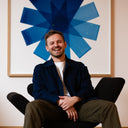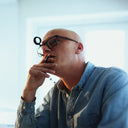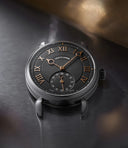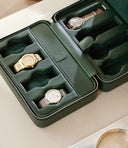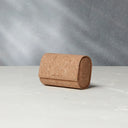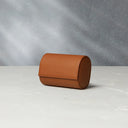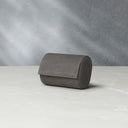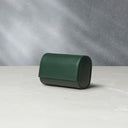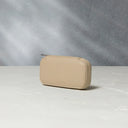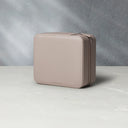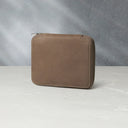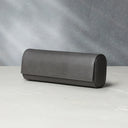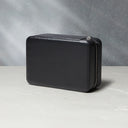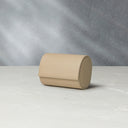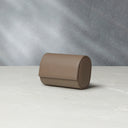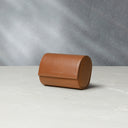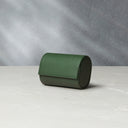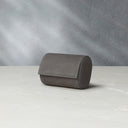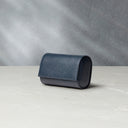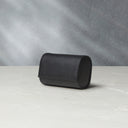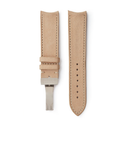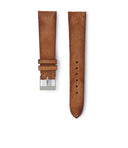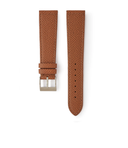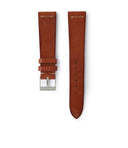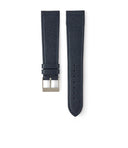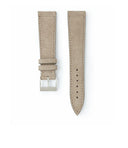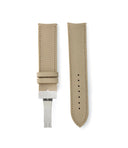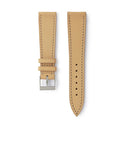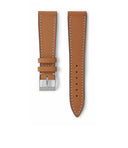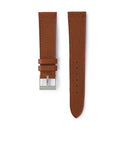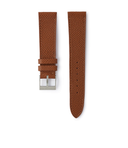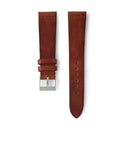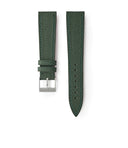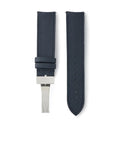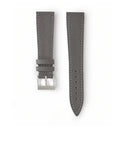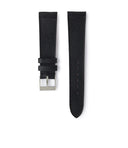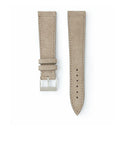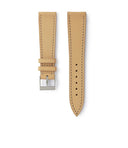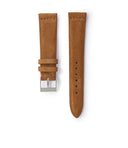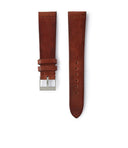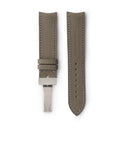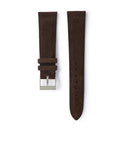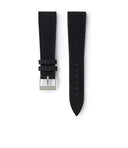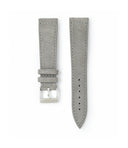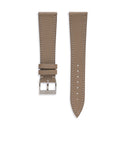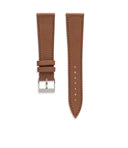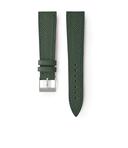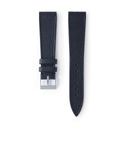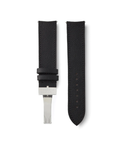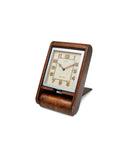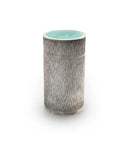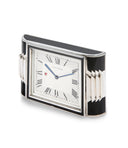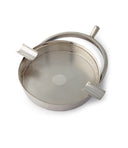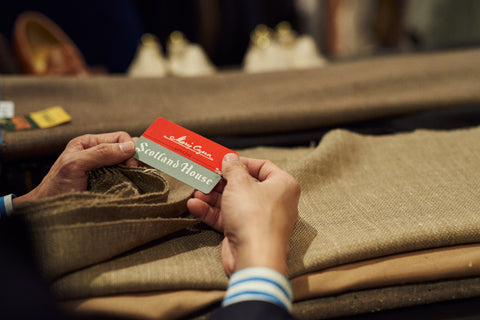
Interview: Han Ates
By Daniel Penny
Han Ates, 54, dressed in jeans and a navy chore coat of his own design, greeted me at the entrance of his shop floor in north London. He had a warm smile, a mop of silvery curls, and on his wrist, an old steel Rolex Oyster he’d picked up on a trip back to his native Istanbul. Ates’ factory was built in the 1920s to make double-glazing windows, but in the intervening 100 years, he has transformed the space into Blackhorse Lane Ateliers, a premium denim factory that makes jeans for some of the best up-and-coming British brands. Studio Nicholson, Drake’s, and King & Tuckfield are all clients, along with a growing cadre of micro-brands and small artisans whom Ates welcomes into the factory with open arms. In a 2018 New York Times roundup of the best denim made in Britain, five of the six brands mentioned in the article were manufactured by Blackhorse. Since opening its doors in 2016, Blackhorse has become the birthplace and incubator of the highest quality denim in the UK, perhaps even the world.

Han Ates at Blackhorse Lane, surrounded by denim style and size templates.
When I arrive on the first warm day in spring, the factory is humming. On my left, a woman traces a paper pattern over a pile of fabric using a buzzsaw. On my right, a man steams and presses finished pairs of jeans before sending them to quality control. The entire manufacturing process takes place here, in a 1200sqm facility – each artisan carefully lining up his stitches, or expertly adding rivets at the jeans’ most integral points.
On the wall is a T-shirt for his other venture, a restaurant at the factory open each weekend called “Slow Burn.” It’s printed with the phrase “Big Veg Energy” with a robust eggplant beneath. Next to the T-shirt is a rectangle of blue denim with an image of the Mona Lisa in shades of light blue and beige; a test, Ates explained, for a new laser-etching and washing facility he is building on site that will allow him to simulate the perfect fades. I had to admit, Mona Lisa’s sleeves were looking very nicely whiskered. In the back of the factory, next to piles of hickory and wide-striped jeans, Ates and I grab a seat and discuss his life in and out of the fashion industry, the importance of connecting with our communities, and the memories we store in old things.
ACM: Thanks again for agreeing to chat with A Collected Man about your life and your experiences. Knowing your mission and getting to know you, it seems like Blackhorse Lane Ateliers is almost on a cultural mission to promote a different way of consuming as much as it is a business. But I know that you had a long career in fashion before starting Blackhorse Lane, and you’ve talked about maybe some of your dissatisfaction with the way things have been done. Can you just elaborate on how you got your start in the industry?


A glimpse into the inner workings of Blackhorse Lane Atelier.
HA: I came to London from Istanbul in 1987. I was 19. In those days, London was a bit dark, in a recession. Lots of shops were closed. But we had a thriving manufacturing scene in London. We had hundreds of factories, and my uncle had a factory in east London, in Dalston. My first job was a presser in his factory. I enrolled in university and I was trying to work part time, and study full time, but somehow I couldn’t manage it, so I went maybe two years to university.
At one point, I became a quality controller for my uncle, and then I left and started my own catering business. Two years down the line, my uncle came to me. By that time, he had opened a second factory, but it wasn’t doing well. It was in a warehouse in north London. He said to me, “You know a little bit [about] textiles. You were a good quality controller. Do you want to take over this factory from me? The price is XYZ and don’t worry about money. You pay me in instalments.”
I inherited, overnight, a huge factory. But even though I was a good quality controller or a presser, I didn’t know much about sewing techniques and patterns, and I wasn’t a tailor. It was a huge responsibility. I was 25. And the customers were coming in very dissatisfied with the quality. One day, I decided to go to Central Saint Martins to enrol myself into the master cutting and sewing techniques course. It was a one-year intensive course. All the other students were either keen tailors or keen pattern cutters. But I had the real thing in my hand, I had the production. Every single problem I had in the factory, I was bringing it to the college and my learning curve [had a trajectory] like a space shuttle. And within six, seven months of the course, we started to produce some of the best garments in London.
What were you making and who were you making it for at that time?
It was predominantly tailored jackets for ladies. We had clients like Jeff Banks, Aquascutum, Principals, Richards, Monsoon. High-end high street. It wasn’t designer, but it was good quality. In the second year of having that factory, I decided to come to this building where we are now. So that was 1996. At the time, I became partners with my father-in-law, and I didn’t have the money to buy and open the factory. He bought the building and it became a very successful factory.

At 25 years old, Ates inherited a huge factory, which focused on making tailored jackets.
How important do you think owning your own real estate has been to your success?
Tremendously important. It gives a sense of security. If I was renting such a warehouse, it would have been impossible because London properties have always been expensive. London labour is expensive compared to the rest of the country. So I’m very fortunate to own this building in that sense.
But in 2001, my customers wanted us to move the production offshore because we were expensive. So we followed that trend because lots of people were going away from UK production. Because I’m from Turkey, I decided to open a big factory just outside of Istanbul.
And what were you making there?
Still the same products, but because production went really much bigger, we started doing skirts, jackets, trousers, coats, etc. So, of course, by 2005, Turkey became expensive too, and China was really opening up.
And they said, “You know, we’re gonna send the production to China, because it’s much cheaper. You have an option, either you go and open a production unit in China, or we’re going to work with somebody else.”
I didn’t want to lose my customers. I went to China. We didn’t open a factory, but we became partners with one factory in Shanghai [and] one factory in Guangzhou. So I was travelling every other week to China. My family was in London. My oldest daughter was born in 1996. And really, by 2006 [or] 2007, I hadn’t seen her growing because I was always on the go.
I became good friends with a couple of Chinese guys there. They were supervisors; they were technical, they knew how to cut patterns and how to solve things. You get closer to those kinds of people because even though the language could be difficult, [the] technical understanding is there.

After moving production from the UK to Turkey, and finally to China, Ates returned to London in 2008.
So one day, this guy says he wants to share some green tea with me. He took me to his dormitory. I see hundreds of beds on top of each other. I was feeling sorry for him because he was away from his children and living in not great conditions. But at that point, I realised actually there was no difference between him and me. I was away from my children for years. So I felt disconnected. I felt dissatisfied. It wasn’t about money anymore.
Just before the financial crash in 2008, I talked to my business partner and said to him, “Look, I want to be with my children, I want to live in London, I want to reconnect with my family.” He bought my shares in the transaction, and I kept the building here.
I know that you owned a restaurant in Stow Newington for a while after that. So when did Blackhorse Lane Ateliers start? Did you think you would go back into fashion?
I’ve been doing years of humanistic psychotherapy. Not to become a psychotherapist, but I wanted to understand that journey. Who are we? In one of these meetings, the theme was “How do you define yourself as an artist?” We had about eight people in the group: writers, psychotherapists, academics, politicians, housewives, businessmen, everybody talking about how they feel connected to their artistic side. When the question came to me, I couldn’t really define myself because I had this amazing, beautiful restaurant. But I wasn’t in the creative state, because I wasn’t the head chef. I was a good host, which is glamorous, really nice. But creatively, you’re not doing much.
I said, “Look, just give me some time, I’m going to think about it.” So about four to five minutes later, when the question came back to me again, I realised I was most happy creatively in this building, when I was producing garments. I was cutting the pattern, measuring it, choosing the fabric, making sure the quality was there. The artistic process is all about imagination. I missed that. And I think “I’m going to go back, but I’m going to go back and do it very differently.” So by that time, it was 2014. In December, I sold the restaurant business. I learned so much in hospitality. One was connectivity. Secondly, in a really good restaurant, the most important thing is the quality of the ingredients. Unfortunately, the fashion world has not discovered that yet.
What do you mean by quality ingredients?
You are as good as your material. If the material is not great, it doesn’t matter what you do – it’s not going to last.
Speaking of quality, we have some jeans here on the table. What are we looking at?
This was my pair, which is nearly 18 years old now. I think I paid £200 at the time. It’s red, double X, premium Levis. And if we look at the inside…
Yeah, it’s really rough. A lot of these loose threads.
I always hated that unfinished edge.
Are you still the same size?
Haha. No. Now 35, this is maybe 30. So this pair is made in Japan. Again, premium.
'I realised I was most happy creatively in this [Blackhorse Lane’s] building, when I was producing garments. I was cutting the pattern, measuring it, choosing the fabric, making sure the quality was there. The artistic process is all about imagination.'
And here you can really see the difference is the quality of the fabric.
But construction is the same again. Rough.
So for you, it wasn’t just about the quality of the fabric. It was about the construction.
It’s interesting, because lots of people say the Japanese do really good jeans. I understand what they mean. But I don’t agree with that. The Japanese took Levi’s as a norm. And look at the construction! This construction hasn’t changed since the 1940s. Now, the Japanese continue to create premium jeans with this as a standard. Because we are trained as tailors, we can’t produce that. We can’t show our customers unfinished seams.

Ates examining a sample of denim.
And for the amount that you’re going to charge for them. It just feels like that’s just not appropriate.
Yeah. Exactly. To me, this is a London handwriting. Because in London when I was at Central Saint Martins, they were drilling in me: in fine tailoring you never show the work. There’s this book, “Nothing is made like the old days” – apart from Blackhorse denim. Because we really believe in the quality, but also it deserves to be cared for.
So in my new business [back in 2014], I decided I was going to focus on quality and follow the craft-beer movement. I was looking at it thinking, “What’s the beer of fashion?” It’s denim: everybody drinks beer, everybody has denim. It is so democratic. And denim is not a fashion item, in my opinion, because it has only one colour – blue. Different shades of blue, but 98% of it is blue. And the older it gets, the better it becomes, so you could do lots of repairs, lots of mending. Doesn’t matter what you do to it. It becomes really attractive. And I said “OK, I’m gonna work with denim,” because at the time in the UK there was not really any craft production of denim.
I wanted to ask you about your business model. It seems like Blackhorse Lane has a great front-facing consumer brand, but you also do a tonne of manufacturing for other brands. Can you just talk a little bit about that model?
I came to that model because I really believe in craft movements. The more makers we have in London, the busier we will be. Thirty years ago, we had so many manufacturers here. And I know that we could never compete with China or we could never compete with Turkey because in those countries labour is cheap. But what we can compete on is quality. I think we still have a big opportunity in cities like London [and] Manchester to produce high-end clothing. We still have the know-how. And I want to give something back to the city. That’s why we work with the University of the Arts London. We are doing a sustainable washing facility here, and our doors will be open to students. This technology is not new; it’s been around for seven or eight years.
Small brands can’t invest £500,000 and also we don’t have the know-how here. So we are creating laundry for research and development.


Up close with his vintage Rolex and turn-ups.
Can you talk about the direction the brand has gone in? I know that you started out with very few employees. It seems like you’re growing, despite Covid.
Steadily. We always say we will never be bigger than this unit. OK, if, let’s say our production and brand becomes bigger, what I would love to do is open an atelier in Paris or New York or in Tokyo with the local tailors, because the exciting thing is local tailors will bring their own knowledge, and the handwriting will be different. We have an open-door policy for our local residents and anybody who wants to come and see how the garments are made. We don’t want to hide behind closed doors. We work with one of the best mills in the world. Their values and their commitment to the environment is important.
Can you talk a bit about that? I saw your philosophy of design on a whiteboard by the entrance, and I know that sustainability is very important to you.
We look at [sustainability] a bit differently. I never say “sustainable’’ here. So even though our laundry will be eco-friendly, because we will be using fewer chemicals, let’s not be naive about that, because so far, where we are technologically, nobody in the world is environmentally sustainable. If anybody says their company is, they’re lying.
So we really look at it differently. We encourage sustainable behaviour, but we ourselves are not. For example, we just started this new newsletter. When you buy jeans from us, a month later, we send you an email saying, “By the way, you have an amazing product, please look after it. These are the washing secrets.”
Your care guide?
Yes. A year later, we remind you to check your garments, and send it to us for repair because we want to repair your garment so that you could use it as long as possible. To me, that’s sustainable behaviour.

In addition to his manufacturing business, Ates has started a sustainable washing facility in an attempt to encourage eco-friendly behaviour.
Tell me about your first pair of jeans, if you can remember them.
Absolutely. It was 1982 or 1983 – I don’t remember. My uncle came from Holland with, I think, two metres of denim fabric that he gave me as a present. In those days, Levi’s were the most popular, but I don’t think we had Levi’s in Turkey. So I went to a local tailor and I said, “Look, I want jeans. Can you make them?” And my local tailor made me jeans and I paid him in three-month instalments.
Wow. With any rivets?
No, no, it was bartack. But still it faded. I loved it. I used it and that was my first pair. Slim, very slim. So that was my made-to-measure jeans. Yeah. I was lucky.
And you do a made-to-measure service now, right?
We started about 14 months ago. Maybe you have an unusual body shape or you just want to treat yourself. We measure your body; you choose the fabric. We also run masterclasses if you’re a keen sewer: you come in, you try a pair and then you maybe go through what you would change. You might say, “I want to make it a bit bulkier or slimmer. I want to change the rise to this many centimetres; change the pocket shapes,” and then we interpret those changes onto the pattern. I take you through each stage of what will happen to your jeans over two days. We make your jeans together. I am supervising you. So you make your own jeans, basically.

Ates believes that clothes should be seen in the same light as timepieces, holding memories that can be passed on.
I imagine Covid was a hard time for everyone in local manufacturing – shutdowns and all of that. And then also, denim jeans purchases were way down during the lockdown. Have things started to come back up?
We were very fortunate because with Covid, people started to question their values. They had more time to think. They understood why local production was so important. Our turnover went up 80%. Supply chains… imagine you are a small producer and you’re working with China. All of a sudden, they’re closed. You need to produce. Ultimately, though, we are not even a drop in the ocean. I think our impact is more philosophical than economical. We produce maybe 15,000 jeans a year, when H&M maybe makes 15,000 a week. It’s a different scale. We really want to change the perception of how people look at their own clothes. We really want people to see their jeans like a timepiece. You know, quality timepieces will last generations – quality clothing as well. And with that you pass on memories. I think that’s really why we need to be emotionally connected to everything we do in life. Without that, life is meaningless, in my opinion.
Our thanks to Han Ates for giving us a glimpse into his life and into the Blackhorse Lane Atelier. Photography by Ollie Grove.







